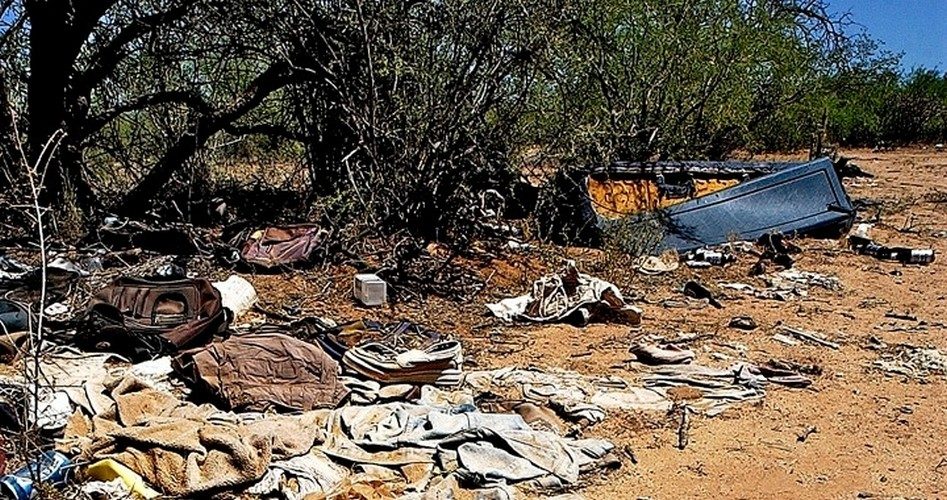
In an effort to curb “high priority” environmental problems along the U.S.-Mexico border, the Environmental Protection Agency (EPA) worked with Mexican officials last week to launch the “Border 2020 U.S.-Mexico Environmental Program.” But while the program seeks to abridge pollution in many areas, it neglects to mention the 1,000 tons of trash abandoned by illegal immigrants crossing the border into the United States.
On August 8, EPA Administrator Lisa Jackson met with Mexico’s Secretary for the Environment and Natural Resources Juan Elvira Quesada to green-light the new environmental program, which seeks to moderate pollution in air, water, and on land, as well as abate exposure to chemicals caused by inadvertent emissions or terrorism. The program is the latest effort administered under the 1983 U.S.-Mexico La Paz Agreement to address environmental and health concerns along the 2,000-mile border region. The Border 2020 Environmental Program hones in on five key areas:
Reducing air pollution in bi-national air sheds by promoting vehicle inspection programs and road paving, and encouraging anti-idling technologies such as diesel truck electrification at ports-of-entry.
Improving access to clean and safe water as well as improving water quality in the bi-national watersheds.
Promoting materials and waste management, and addressing contaminated sites as well as management practices for addressing electronics, lead acid batteries, tires, and trash.
Enhancing joint preparedness for environmental and emergency response.
Enhancing compliance assurance and environmental stewardship.
The Border 2020 plan asserts that “protecting the health and the environment in the border region is essential to ensuring that the U.S. continues to be safe, healthy, and economically productive.” However, the EPA and Mexican officials have neglected the more than 500 tons of trash and over 100 abandoned vehicles at just one national wildlife refuge along the Arizona border. They also neglect to mention the environmental and safety threats stemming from human and drug trafficking and other illegal activities arising from people who are illegally crossing the border.
According to the Arizona Department of Environmental Quality (ADEQ), illegals who have been trashing the border have become a “huge problem” in Arizona, the most active corridor for illegal immigration. Last year, illegal immigrants abandoned about 1,000 tons of trash along the border, affirmed ADEQ spokesman Mark Shaffer.
Meanwhile, the Government Accountability Office (GAO) says “illegal border activities” along the U.S.-Mexico border constitute “a threat to both public health and safety.” In a December 2010 report to the House Committee on Natural Resources, the GAO stated that such environmental and safety damage prompted by “illegal border activity” was “substantial.”
“Law enforcement officials told us that some remote federal lands along the U.S. border are often used to smuggle drugs or humans into the country,” the GAO report asserts. “According to these officials, such illegal activities can damage sensitive wildlife habitat and threaten public safety.”
The trashing of the border has become a severe “environmental problem,” the GAO disclosed, and “officials at every unit we visited in Arizona reported substantial natural resource damage from illegal border activity.” Pointing to one national wildlife refuge that sits right along the Arizona border, the GAO described the social and environmental impact illegal immigration has imposed on the area.
“In 2006, for example, the Refuge Manager of Buenos Aires National Wildlife Refuge testified before the House of Representative’s Subcommittee on Interior, Environment, and Related Agencies of the Committee on Appropriations that an estimated 235,000 people entered the United States illegally across refuge lands in 2005,” the report noted. “He reported that illegal border crossers had disturbed wildlife and created more than 1,300 miles of illegal trails, causing the loss of vegetation and severe erosion.”
Furthermore, illegal border crossers have ignited wildfires, either inadvertently or on purpose, to draw law enforcement away from certain areas. The GAO also noted that some endangered species are being harmed from illegal border crossers. “Officials at Buenos Aires National Wildlife Refuge [Arizona] told us that illegal border activity was damaging sensitive desert ecosystems,” the report continued, “including habitat for several threatened or endangered species, such as the masked bobwhite quail and Sonoran pronghorn — although the officials were unable to quantify the effects of illegal activity on these populations.”
But the EPA and Mexican government officials are ignoring these environmental and health problems, as well as members of the public and law enforcement employees who have fallen victim to rape, assault, homicide, and other acts of violence. CNSNews.com asked the EPA why the health and environmental damage that stems from illegal immigration is omitted in the agreement. The EPA’s response? That is “outside the jurisdiction of EPA and the Border 2020 Program.”
Photo of trash left by illegal immigrants along the U.S.-Mexico border: AP Images



